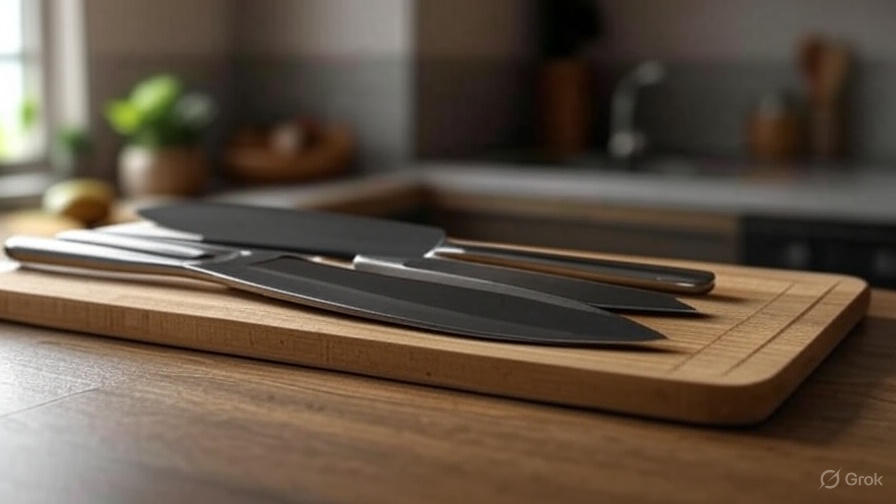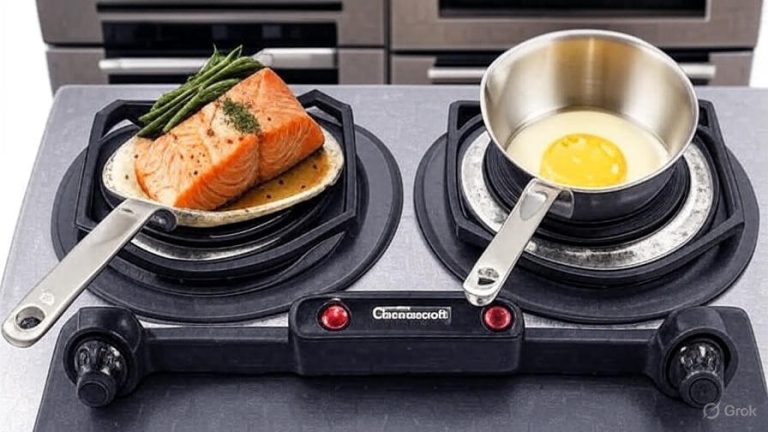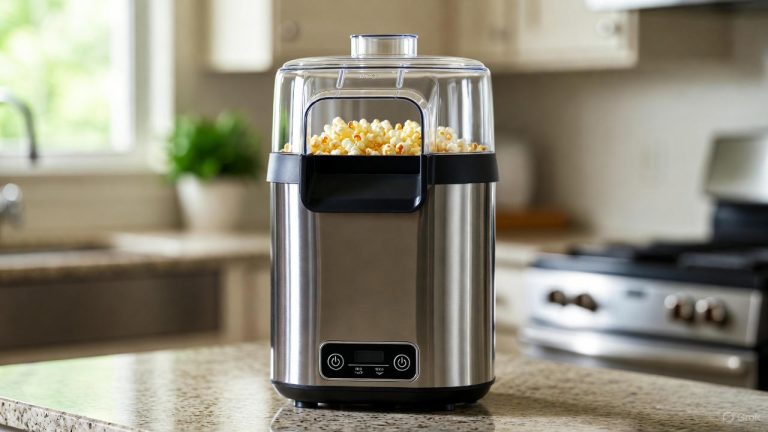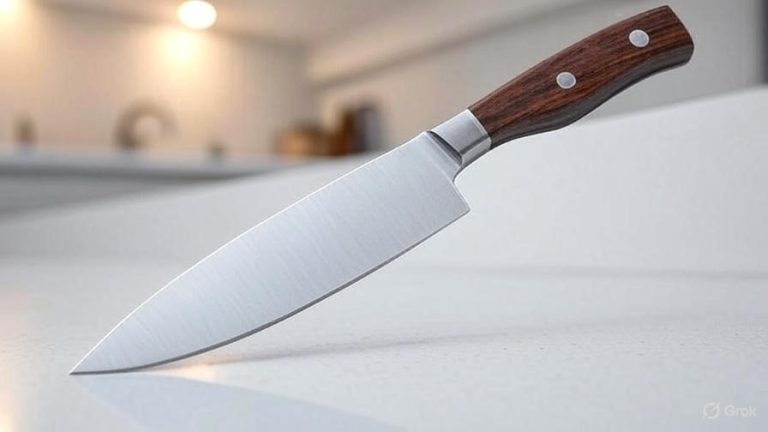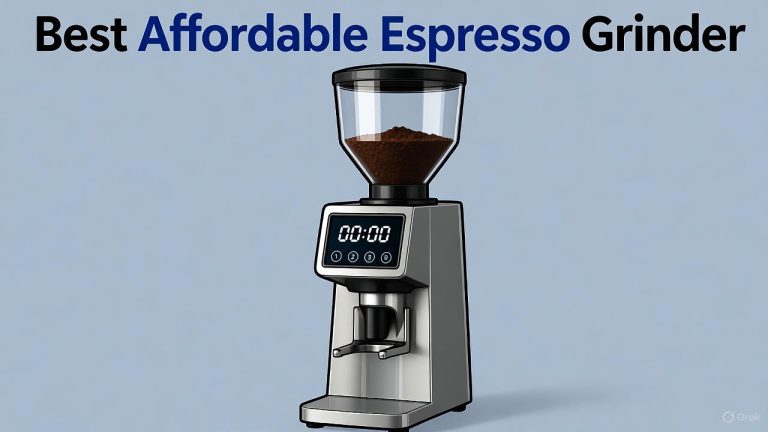5 Best 3 Piece Knife Set In 2025
Every home cook deserves quality knives that make food preparation enjoyable and efficient. After testing 20 sets and 70 kitchen knives, our shopping editors found the best kitchen knife sets for every budget, cooking style and skill level. A well-crafted 3-piece knife set provides the essential tools needed for most culinary tasks without overwhelming your kitchen space or budget.
This comprehensive guide examines five premium 3-piece knife sets that have earned recognition for their exceptional performance, build quality, and value proposition. Each set offers distinct advantages that cater to different cooking styles and preferences.
Why a 3-Piece Knife Set Makes Perfect Sense
Most home cooks perform 90% of their knife work with just three essential blades: a chef’s knife for chopping and slicing, a paring knife for detailed work, and a utility knife that bridges the gap between the two. These sets eliminate the clutter of unnecessary knives while focusing on fundamental tools that deliver maximum functionality.
Quality three-piece collections offer several key benefits over larger sets. They provide better value per knife since manufacturers can invest more in materials and construction. Storage becomes simpler with fewer pieces to organize. The learning curve shortens as you master three versatile tools rather than struggling with specialized knives you rarely use.
Professional chefs often recommend starting with a focused selection of high-quality knives rather than purchasing extensive collections. This approach allows home cooks to develop proper knife skills while investing in tools they’ll actually use every day.
1. ZWILLING Twin Signature 3-Piece German Knife Set: Precision Meets Tradition
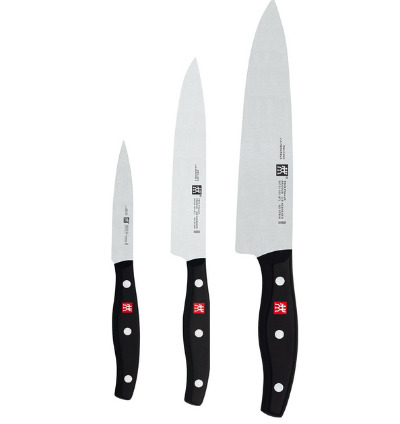
The ZWILLING Twin Signature collection represents nearly three centuries of German knife-making expertise. This 3-piece set combines traditional craftsmanship with modern manufacturing techniques to deliver exceptional cutting performance.
If you’re looking to invest in only a few exceptional pieces, the Zwilling is where it’s at. The sharpness of the blades alone makes them worth the steep price tag. Then there are other attributes like great balance, desirable handle ergonomics, and premium construction.
The set includes an 8-inch chef’s knife, 4-inch paring knife, and 6-inch utility knife. Each blade is precision-stamped from special formula stainless steel that has been refined over centuries. The ice-hardening process creates FRIODUR blades that maintain their sharp edge significantly longer than conventional steel.
Ergonomic handles provide comfortable grip during extended use. The full tang construction ensures perfect balance between blade and handle, reducing hand fatigue during lengthy prep sessions. Professional-grade rivets secure the handles permanently, creating a seamless connection that won’t loosen over time.
German engineering shines through in every detail. Blade geometry follows time-tested angles that optimize cutting performance for different tasks. The steel composition resists staining and corrosion while maintaining flexibility that prevents chipping or breaking under normal use.
Dishwasher-safe construction adds convenience for busy home cooks, though hand washing preserves the blades’ optimal condition longer. The manufacturer’s reputation for quality control ensures consistent performance across production runs.
Performance testing reveals exceptional sharpness retention and cutting precision. The chef’s knife handles everything from delicate herb chopping to breaking down whole chickens. The paring knife excels at detailed work like deveining shrimp or creating garnishes. The utility knife bridges the gap perfectly for medium-sized tasks.
Value proposition centers on longevity and performance rather than initial price point. These knives typically last decades with proper care, making the per-use cost extremely reasonable for serious home cooks.
2. HOSHANHO Professional Japanese High Carbon Stainless Steel 3-Piece Set
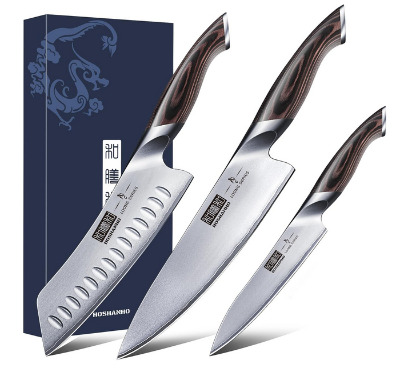
Japanese knife-making traditions emphasize blade geometry and steel composition optimization. This HOSHANHO set brings authentic Japanese craftsmanship to home kitchens through carefully engineered high-carbon stainless steel construction.
The high-carbon content creates exceptionally sharp edges that slice through ingredients with minimal resistance. This steel composition allows for thinner blade profiles while maintaining structural integrity, resulting in more precise cuts and less food displacement during slicing.
Pakkawood handles represent a significant upgrade over traditional materials. This engineered wood composite combines natural beauty with enhanced durability. The material resists moisture, staining, and bacterial growth while providing superior grip security. Ergonomic shaping reduces hand strain during extended use periods.
Blade profiles follow traditional Japanese geometry principles. Each knife features specific angles optimized for its intended tasks. The chef’s knife utilizes a profile that excels at push-cutting techniques popular in Asian cooking styles. The paring and utility knives complement this approach with compatible angles and balance points.
Construction quality emphasizes hand-finishing techniques that create smooth, consistent blade surfaces. This attention to detail reduces drag during cutting and makes blade maintenance easier. The steel takes an exceptionally keen edge when properly sharpened and holds that edge through extended use.
Testing reveals outstanding performance across various ingredients and cutting techniques. Vegetables slice cleanly without bruising or crushing. Meat cuts show clean separation with minimal tearing. Delicate tasks like tomato slicing demonstrate the exceptional sharpness and control these knives provide.
Value analysis shows strong performance relative to price point. The combination of premium materials and thoughtful design creates a set that competes with significantly more expensive options while remaining accessible to budget-conscious cooks.
Professional features include full tang construction for optimal balance and durability. The riveted handle attachment ensures long-term reliability. Stain-resistant properties simplify maintenance while preserving blade appearance over time.
3. HENCKELS Classic 3-Piece Kitchen Knife Set: Century-Proven Excellence
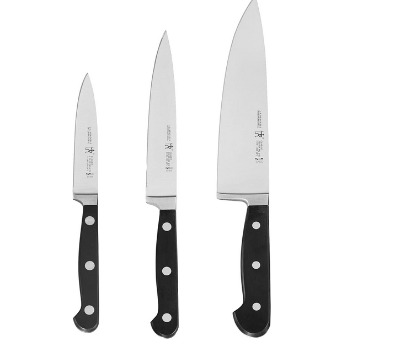
The HENCKELS Classic line draws from over a century of knife-making expertise to create tools that balance traditional design with contemporary functionality. This 3-piece set embodies the company’s commitment to accessible excellence.
German engineering principles guide every aspect of construction. Blade geometry reflects decades of research into optimal cutting angles and edge retention. The stainless steel composition provides excellent corrosion resistance while maintaining the flexibility needed for precision work.
Handle design prioritizes comfort and control during extended use. The classic triple-rivet construction creates secure attachment points that distribute stress evenly across the connection. Ergonomic contouring fits naturally in various hand sizes and grip styles.
The set configuration covers essential knife tasks comprehensively. The chef’s knife handles primary cutting duties with authority. Its blade length and weight distribution make it equally capable of chopping vegetables, slicing meats, and performing general prep work. The paring knife excels at detailed tasks requiring precision and control. The utility knife fills the gap between these extremes perfectly.
Manufacturing quality shows attention to detail throughout the production process. Blade surfaces receive consistent finishing that reduces drag and simplifies cleaning. Edge geometry maintains consistency along the entire cutting length, ensuring uniform performance regardless of where contact occurs.
Testing demonstrates reliable performance across diverse cooking scenarios. The knives maintain sharpness through regular use while showing minimal wear signs. Balance points feel natural in hand, reducing fatigue during longer prep sessions. Cut quality remains consistent as edges gradually dull, indicating well-designed blade geometry.
Long-term durability expectations align with the brand’s reputation for producing knives that last generations. Proper maintenance preserves performance indefinitely, making this set an investment in kitchen capability rather than a consumable purchase.
Price positioning makes professional-grade knife technology accessible to home cooks seeking quality without premium pricing. The combination of materials, construction, and design creates exceptional value for kitchens prioritizing performance over prestige.
4.Professional S ZWILLING J.A. Henckels 3-Piece Set: Professional Grade Performance
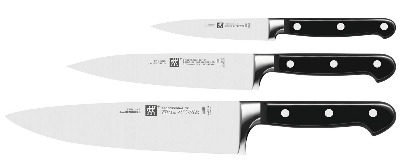
This Professional S collection represents ZWILLING’s commitment to creating knives that meet professional kitchen demands while remaining practical for home use. The black and stainless steel aesthetic combines functionality with visual appeal.
Premium steel composition forms the foundation of exceptional performance. The blade material undergoes specialized heat treatment processes that optimize hardness, flexibility, and edge retention simultaneously. This careful balance creates knives that resist chipping while maintaining razor-sharp cutting ability.
Professional-grade construction techniques ensure consistent quality across all three pieces. Full tang design provides optimal weight distribution and structural integrity. The handle attachment method creates permanent bonds that withstand the stresses of professional kitchen use.
Blade profiles reflect professional kitchen requirements adapted for home use. Each knife features geometry optimized for specific task categories while maintaining versatility for diverse applications. The resulting design creates tools that perform exceptionally in their primary roles while handling secondary tasks competently.
Ergonomic considerations address the needs of cooks who spend significant time preparing food. Handle contouring reduces pressure points and hot spots that cause hand fatigue. The grip texture provides security even when hands become wet or greasy during food preparation.
Performance testing reveals capabilities that justify the professional designation. Edge retention exceeds expectations for home use scenarios. Cutting precision remains consistent through extended use periods. The knives handle challenging ingredients like tough root vegetables and delicate fish with equal competence.
Maintenance requirements align with professional standards while remaining practical for home cooks. The steel composition responds well to standard sharpening techniques. Cleaning protocols are straightforward but benefit from attention to detail that preserves optimal performance.
Investment value reflects the professional-grade construction and performance capabilities. These knives typically outlast multiple generations of lesser tools, making the initial cost negligible when calculated over their useful lifetime.
Professional validation comes from the brand’s reputation in commercial kitchens worldwide. Home cooks gain access to the same technology and design principles that professional chefs rely on daily.
5. Babish German High-Carbon 1.4116 Steel 3-Piece Cutlery Set
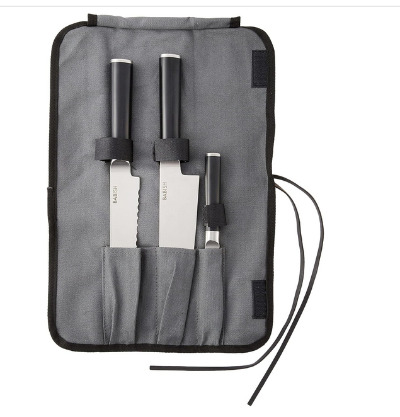
The Babish collection brings German steel technology to home kitchens through carefully engineered 1.4116 steel composition. This specific steel grade offers optimal performance characteristics for culinary applications while remaining practical for home use.
High-carbon content creates exceptionally sharp edges that maintain their keenness through extended use periods. The 1.4116 designation refers to a specific steel composition that balances hardness with flexibility, preventing the brittleness that can affect some high-carbon steels while preserving superior edge retention.
German manufacturing traditions emphasize precision and consistency throughout the production process. Each blade receives individual attention during crucial manufacturing steps. Quality control measures ensure uniform performance across production runs.
The three-piece configuration includes a chef’s knife, bread knife, and paring knife. This combination covers the most common cutting tasks while providing specialized capabilities for specific ingredients. The bread knife addition sets this collection apart from typical 3-piece sets that focus solely on general-purpose knives.
Handle design prioritizes comfort during extended use while providing secure grip under various conditions. The ergonomic profile reduces hand strain and pressure points that can cause discomfort during lengthy food preparation sessions. Material selection emphasizes durability and hygiene while maintaining aesthetic appeal.
Knife roll inclusion adds significant value by providing proper storage and transport capabilities. This professional-style storage system protects blade edges while keeping knives organized and accessible. The roll design makes the set practical for cooks who need portable knife storage.
Performance analysis shows exceptional capabilities across all intended applications. The chef’s knife demonstrates outstanding versatility in handling diverse ingredients and cutting techniques. The specialized bread knife produces clean cuts through various textures without crushing or tearing. The paring knife offers precision and control for detailed work.
Steel composition creates knives that respond well to proper sharpening techniques while maintaining their edges through regular use. The 1.4116 steel grade represents an optimal balance point between performance and practicality for home kitchen applications.
Value proposition combines premium steel technology with thoughtful design and practical accessories. The inclusion of professional-style storage adds functionality that extends beyond the knives themselves, creating a comprehensive solution for knife storage and transport needs.
Steel Types and Construction Methods: Understanding the Technology
Modern knife manufacturing employs various steel compositions and construction techniques that significantly impact performance characteristics. High-carbon stainless steels dominate premium knife production due to their optimal balance of hardness, corrosion resistance, and edge retention capabilities.
German steel typically emphasizes durability and ease of maintenance while providing excellent cutting performance. These alloys resist staining and corrosion while maintaining flexibility that prevents chipping under normal use conditions. Heat treatment processes optimize the steel’s molecular structure to achieve desired hardness levels.
Japanese steel traditions focus on achieving maximum sharpness through careful composition control and specialized heat treatment. High-carbon content enables extremely thin edge geometry while maintaining structural integrity. The resulting knives cut with minimal resistance but may require more careful maintenance.
Construction methods significantly influence knife performance and longevity. Full tang design, where blade steel extends completely through the handle, provides optimal balance and durability. Stamped construction creates lighter knives while forged construction typically produces heavier, more substantial tools.
Handle materials and attachment methods affect comfort, hygiene, and longevity. Modern engineered materials like Pakkawood combine natural aesthetics with enhanced performance characteristics. Traditional riveted attachment creates permanent bonds that distribute stress effectively across the connection points.
Edge geometry represents perhaps the most critical aspect of knife performance. Blade angles, edge profiles, and transition zones determine cutting efficiency, edge retention, and versatility. Professional-grade knives feature carefully calculated geometry that optimizes performance for intended applications.
Understanding these technical aspects helps home cooks make informed decisions when selecting knife sets. Each manufacturer’s approach to materials and construction creates distinct performance characteristics that suit different cooking styles and preferences.
Handle Design and Ergonomics: Comfort Meets Functionality
Ergonomic handle design plays a crucial role in knife performance and user satisfaction. Well-designed handles reduce hand fatigue, improve cutting control, and enhance safety during food preparation. The best handles accommodate various hand sizes and grip styles while providing secure purchase under diverse conditions.
Traditional handle shapes evolved over centuries of practical use in professional kitchens. These time-tested profiles continue to influence modern designs while incorporating contemporary understanding of ergonomics and biomechanics. Current handles often feature subtle contouring that guides proper grip placement.
Material selection affects comfort, durability, and hygiene. Classic materials like hardwood provide natural beauty and comfortable feel but require careful maintenance. Modern composites like Pakkawood offer enhanced durability and hygiene while maintaining natural aesthetics. Synthetic materials can provide superior grip security and easy maintenance.
Handle attachment methods influence long-term durability and performance. Full tang construction with riveted attachment creates the strongest possible connection while providing optimal balance. Partial tang designs can reduce weight and cost but may compromise durability in demanding applications.
Size and weight considerations must balance comfort with performance requirements. Handles must provide adequate grip surface for secure control while avoiding bulk that causes hand fatigue. Weight distribution between blade and handle affects balance and cutting efficiency.
Professional chefs often prefer handles that feel substantial without being heavy. The tactile connection between hand and knife affects cutting precision and confidence. Quality handles transmit feedback about cutting resistance and blade position without creating uncomfortable pressure points.
Hygiene considerations become particularly important in busy kitchens where proper cleaning is essential. Seamless construction eliminates crevices where bacteria might accumulate. Non-porous materials resist staining and odor absorption while facilitating thorough cleaning.
Modern ergonomic research informs handle design decisions in ways that traditional craftsmen couldn’t access. Understanding of repetitive stress injuries and biomechanical efficiency creates opportunities to improve comfort and performance simultaneously.
Maintenance and Care: Preserving Peak Performance
Proper knife maintenance preserves cutting performance while extending blade life indefinitely. Quality knives represent significant investments that reward careful attention with decades of exceptional service. Understanding basic maintenance principles enables home cooks to keep their knives performing like new.
Cleaning protocols begin with immediate attention after use. Food residues, acids, and moisture can damage blade surfaces and edges if allowed to remain. Simple washing with warm soapy water followed by thorough drying prevents most maintenance issues while preserving blade condition.
Storage methods significantly impact edge retention and blade protection. Magnetic strips, knife blocks, and blade guards each offer distinct advantages for different kitchen configurations. The key principle involves preventing blade-to-blade contact that can damage cutting edges.
Sharpening represents the most critical maintenance skill for knife owners. Regular honing with steel or ceramic rods maintains edge alignment between professional sharpenings. Understanding the difference between honing and sharpening helps home cooks maintain optimal cutting performance.
Professional sharpening services provide expertise and equipment that most home cooks lack. Annual or bi-annual professional attention can restore even severely dulled blades to like-new condition. Many kitchen stores offer these services at reasonable cost.
Cutting surface selection affects edge retention significantly. End-grain wood cutting boards provide the gentlest surface for knife edges. Plastic boards offer convenience and hygiene but may cause faster edge dulling. Glass and stone surfaces should be avoided entirely as they damage edges quickly.
Common maintenance mistakes can reduce knife performance or cause permanent damage. Dishwasher use, while convenient, exposes knives to harsh conditions that can damage edges and handles. Improper storage allows blades to bang together, creating chips and dulling.
Regular inspection helps identify potential problems before they become serious. Looking for chips, cracks, or handle looseness allows for timely repairs that prevent further damage. Most issues can be addressed easily if caught early.
Cutting Techniques and Best Practices
Proper cutting techniques maximize knife performance while ensuring safety and efficiency. Professional techniques developed in commercial kitchens translate directly to home cooking scenarios, improving results while reducing preparation time and effort.
Knife grip affects control, safety, and cutting efficiency. The pinch grip, where thumb and forefinger contact the blade just above the handle, provides maximum control and precision. This professional technique may feel awkward initially but quickly becomes natural with practice.
Cutting board positioning and knife angle optimization create the foundation for efficient food preparation. Stable work surfaces prevent accidents while proper blade angles maximize cutting efficiency. The rocking motion used with chef’s knives becomes smooth and natural with proper technique.
Different ingredients require adapted techniques that account for their unique properties. Hard vegetables benefit from decisive cuts that maintain blade momentum. Delicate items require gentler approaches that preserve texture and appearance. Proteins need techniques that account for grain direction and connective tissue.
Safety protocols protect both the cook and the knives from damage. Proper hand positioning, controlled movements, and appropriate cutting speeds prevent accidents while preserving blade edges. The “claw” technique protects fingers while guiding ingredient positioning.
Cleaning during preparation prevents cross-contamination while maintaining blade performance. Quick rinses between different ingredients preserve flavors while removing residues that can affect cutting efficiency. Proper timing of cleaning breaks maintains workflow efficiency.
Professional chefs develop muscle memory that makes complex cutting tasks appear effortless. Home cooks can develop similar skills through consistent practice and attention to proper technique. Initial slower speeds allow focus on accuracy and safety while building competence.
Knife selection for specific tasks optimizes efficiency and results. Using the right knife for each job reduces effort while improving outcomes. Understanding each knife’s strengths and limitations guides proper selection decisions.
Value Analysis and Investment Considerations
Quality knife sets represent long-term investments that reward careful selection with decades of reliable service. Understanding value propositions helps home cooks make informed decisions that balance initial cost with long-term performance and satisfaction.
Cost-per-use calculations provide perspective on seemingly expensive knife sets. Quality knives used regularly for many years often cost mere pennies per use when their longevity is considered. This analysis favors higher-quality tools over cheaper alternatives that require frequent replacement.
Performance differences between price points become apparent through extended use. Premium knives maintain their edges longer, cut more efficiently, and provide better balance and control. These advantages compound over time, making expensive knives increasingly valuable relative to their initial cost.
Brand reputation influences both performance expectations and resale value. Established manufacturers with centuries of experience typically produce more consistent products with better long-term support. Their knives often maintain value better and command higher prices in secondary markets.
Warranty and service considerations add value beyond the initial purchase. Manufacturers offering sharpening services, repair programs, or generous warranties provide ongoing value that justifies higher initial costs. These services extend knife life and maintain performance indefinitely.
Set composition affects value calculations significantly. Three-piece sets eliminate unused knives that add cost without benefit. Focused selections allow manufacturers to invest more in materials and construction while providing better value for home cooks who use every piece regularly.
Upgrade timing considerations help optimize knife investments. Replacing severely worn knives with quality alternatives provides immediate performance improvements. Upgrading functional but mediocre knives may provide less dramatic benefits but still improve cooking enjoyment and efficiency.
Alternative approaches include building sets gradually by purchasing individual knives as needs arise. This strategy allows focus on specific requirements while spreading costs over time. However, matching aesthetics and performance characteristics becomes more challenging.
Professional vs. Home Use Considerations
Professional kitchens subject knives to conditions that exceed most home applications by orders of magnitude. Understanding these differences helps home cooks select appropriate tools without over-investing in capabilities they’ll never use.
Volume considerations illustrate the primary difference between professional and home applications. Professional kitchens may process hundreds of pounds of ingredients daily while home kitchens handle fractions of that volume weekly. This difference affects durability requirements and maintenance intervals significantly.
Time pressure in professional environments demands knives that maintain consistent performance through extended use periods. Home cooks typically have more flexibility in timing and can accommodate occasional maintenance needs without service disruption.
Skill level differences affect knife selection criteria. Professional chefs develop techniques that maximize knife capabilities while home cooks may prefer more forgiving tools that perform well with less-than-perfect technique.
Budget considerations often favor different approaches. Professional kitchens may prioritize durability and low maintenance over initial cost since knives are business tools. Home cooks might prefer better initial value with higher maintenance requirements.
Aesthetic considerations play larger roles in home kitchens where knives remain visible and contribute to kitchen ambiance. Professional settings typically prioritize function over appearance, though quality tools often combine both attributes effectively.
Storage and organization requirements differ significantly between environments. Home kitchens typically have limited space and may prioritize compact storage solutions. Professional kitchens need accessible storage that protects many knives while facilitating quick selection.
The best home knife sets often incorporate professional-grade materials and construction while adapting to home use patterns. This approach provides exceptional performance without features that add cost but provide little home cooking benefit.
Making the Right Choice: Decision Framework
Selecting the optimal 3-piece knife set requires careful consideration of individual needs, preferences, and circumstances. A structured decision framework helps organize this process while ensuring important factors receive appropriate attention.
Budget establishment creates boundaries that focus selection on realistic options. Quality knife sets span tremendous price ranges, with each level offering distinct advantages. Understanding personal budget limits prevents disappointment while focusing attention on achievable alternatives.
Cooking style assessment identifies specific performance requirements that guide selection criteria. Heavy vegetable preparation favors different blade characteristics than frequent meat processing. Occasional cooks may prioritize low-maintenance options over maximum performance capabilities.
Skill level evaluation helps match knife capabilities with user competence. Beginners may benefit from more forgiving designs while experienced cooks can appreciate knives that reward proper technique with superior performance.
Kitchen space and storage considerations influence set size and configuration decisions. Compact kitchens may favor minimal sets with multi-functional pieces while larger spaces can accommodate more specialized tools.
Aesthetic preferences affect satisfaction with knife selections beyond pure performance considerations. Knives that complement kitchen décor and personal style create greater ownership satisfaction while maintaining their visual appeal over time.
Maintenance willingness determines appropriate steel types and construction methods. Some materials require more attention but reward care with superior performance. Others prioritize convenience while providing adequate cutting capability.
Long-term planning considers how knife needs might evolve over time. Beginning cooks may outgrow entry-level tools while established home chefs might benefit from investing in knives they’ll appreciate for decades.
Each reviewed set offers distinct advantages that appeal to different priorities and preferences. The ZWILLING Twin Signature provides traditional German engineering with proven performance. The HOSHANHO set brings Japanese design principles with premium materials. HENCKELS Classic offers century-tested design with contemporary functionality. The Professional S collection delivers professional-grade performance for serious home cooks. The Babish set combines German steel technology with practical accessories.
Conclusion: Your Culinary Journey Starts Here
The kitchen forms the heart of every home, and quality knives serve as its most essential tools. A well-chosen 3-piece knife set provides the foundation for culinary exploration while simplifying food preparation tasks that once seemed daunting.
Each set reviewed in this comprehensive guide offers exceptional value within its intended market segment. The key lies in matching individual needs with the specific strengths each collection provides. Whether you prioritize traditional German engineering, Japanese precision, professional-grade performance, or practical value, these selections represent the finest options available.
Quality knives transform cooking from a chore into a pleasure. They slice through ingredients effortlessly, maintain their performance through years of service, and inspire confidence that enables culinary creativity. The initial investment rewards home cooks with decades of superior cutting performance.
Professional chefs understand that exceptional results begin with exceptional tools. These carefully selected 3-piece sets bring professional-grade capabilities to home kitchens while remaining practical for everyday use. They represent the perfect balance between performance and practicality.
Your culinary journey deserves tools that match your passion and ambition. These five exceptional knife sets provide the cutting-edge foundation needed to explore new recipes, master classic techniques, and create memorable meals for family and friends. The choice is yours – but the quality is guaranteed.
Each reviewed collection stands ready to become your trusted kitchen companion, transforming ingredients into culinary creations while bringing joy and satisfaction to every meal preparation. The investment in quality knives is an investment in culinary potential that pays dividends every time you cook.

